Star Wars Legends, formerly known as the Expanded Universe (abbreviated EU), encompasses every one of the licensed and background stories of the Star Wars universe, outside of the original six Star Wars films produced by George Lucas and certain other material created before April 25, 2014, excluding the animated series Star Wars: The Clone Wars. It is derived from and includes most official Star Wars books, comic books, video games, spin-off films, television series, toys, and other media created before that date. This material expands and continues the stories told in the films, taking place anywhere from over 36,000 years before The Phantom Menace to 136 years after Return of the Jedi.
On April 25, 2014, Lucasfilm Ltd. announced that in preparation for the upcoming sequel trilogy, the Expanded Universe would be rebranded as Legends and no longer adhered to; past tales of the Expanded Universe would be printed under the Star Wars Legends banner, and a new continuity would be established that consisted only of the original six films, Star Wars: The Clone Wars, and all future material from that point onward. Though the majority of the Expanded Universe media was not brought into the new canon, it still remains a resource for future Star Wars materials to reference, thus bringing these older elements into the new continuity. Today, some of the only Legends products that are still being released are the video game Star Wars: The Old Republic, along with short stories published on the Star Wars blog.
The Expanded Universe had a continuity with few wrinkles. The general rule was that nothing in the Expanded Universe was allowed to contradict any other part of the Expanded Universe or the films. For the most part when any discrepancies arose retcons were created to fix these contradictions.
The Expanded Universe is actually older than the films themselves, as the novelization of the original film was published six months before the film was released. In in-universe chronology, the earliest works are the Dawn of the Jedi comics, which are set millennia before the films, while the latest are the Legacy comics, which are set about one hundred and thirty years after Return of the Jedi.
The early development of the Expanded Universe was sporadic and unrefined, in large part because, at this time, there was so little canon material for the creators to use as reference.
The Expanded Universe is generally considered to have begun with Alan Dean Foster's February 1978 Star Wars spin-off novel, Splinter of the Mind's Eye, although technically it began in October 1977 with the story "The Keeper's World," in Marvel Comics' Pizzazz magazine. Splinter drew inspiration primarily from an early draft of the Star Wars script. Although George Lucas's name is on the cover of the original Star Wars novelization, Alan Dean Foster ghostwrote it. Foster was given a copy of the working script and a tour of the production.
Much of the early Legends material from the early 1980s contained analogies to the real world, which belied the impression that the Star Wars universe had no connection to Earth or our own time.
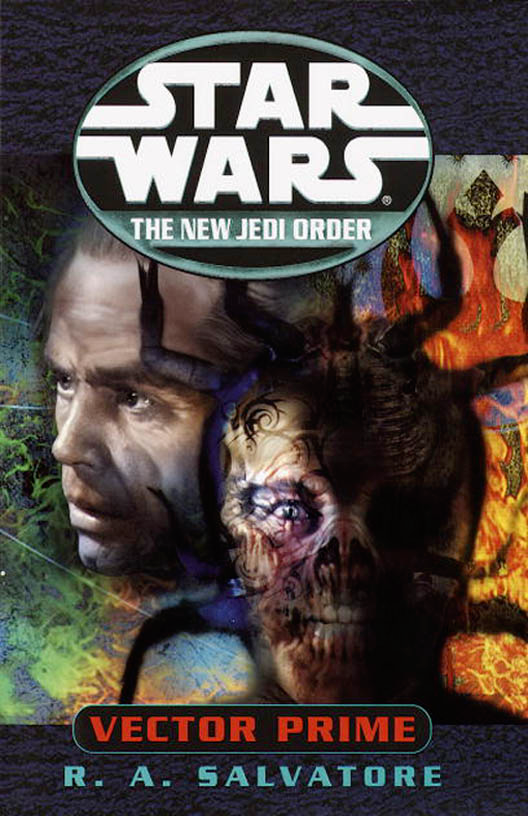
Vector Prime introduced a new threat called the Yuuzhan Vong to the saga.
A turning point was reached when West End Games began publishing the Star Wars: The Roleplaying Game in 1987. In order for players of the roleplaying game to create new adventures, West End Games needed to provide supplemental material describing the Star Wars universe in previously unknown detail and to make it self-consistent and coherent. As an example, the Aurebesh alphabet was originally a random piece of set dressing used in Return of the Jedi. Stephen Crane copied those symbols and turned them into a complete and workable alphabet which would later be used in the prequel trilogy. Developing and extrapolating from details like this in a consistent fashion turned West End Games' Star Wars products into a de facto reference library for other developers of the EU.
Around the same time, Dark Horse Comics acquired the Star Wars license previously owned by Marvel and used it to launch a number of ambitious sequels to the original trilogy, which began with the popular Star Wars: Dark Empire series.
At the same time as Dark Empires release in the early 1990s, Bantam Spectra published Timothy Zahn's The Thrawn Trilogy. Widely publicized as the "sequels which were never made," Zahn's novels reignited Star Wars fandom and sparked a revolution in Star Wars literature.
All this development began to feed back and reference itself and create cross-connections. West End Games produced roleplaying supplements based upon Dark Horse's comics and Zahn's novels. Novelists and comic creators used West End Games' supplements as reference material. Sequels to the novels were being published as comics and vice versa, and the scope of the Expanded Universe grew at a prodigious rate.
At that point, the bulk of the Expanded Universe has detailed the Star Wars universe after the end of Return of the Jedi, as numerous topics, including the rise of the Galactic Empire, the personal histories of Anakin Skywalker and Emperor Palpatine, and the Clone Wars had been declared off-limits by George Lucas prior to the development of his prequel trilogy and related material.
It was decided in the late '90s that using the Empire as the villains had become repetitive and monotonous. A new threat, the Yuuzhan Vong, was introduced in the New Jedi Order series. Specifically, the Yuuzhan Vong first appeared in the first New Jedi Order book, The New Jedi Order: Vector Prime.
Prior to the release of The Phantom Menace, Lucasfilm specifically prohibited development of the decades prior to A New Hope in the Expanded Universe. The release of Episode I, however, opened an entire new era of the series to explore.
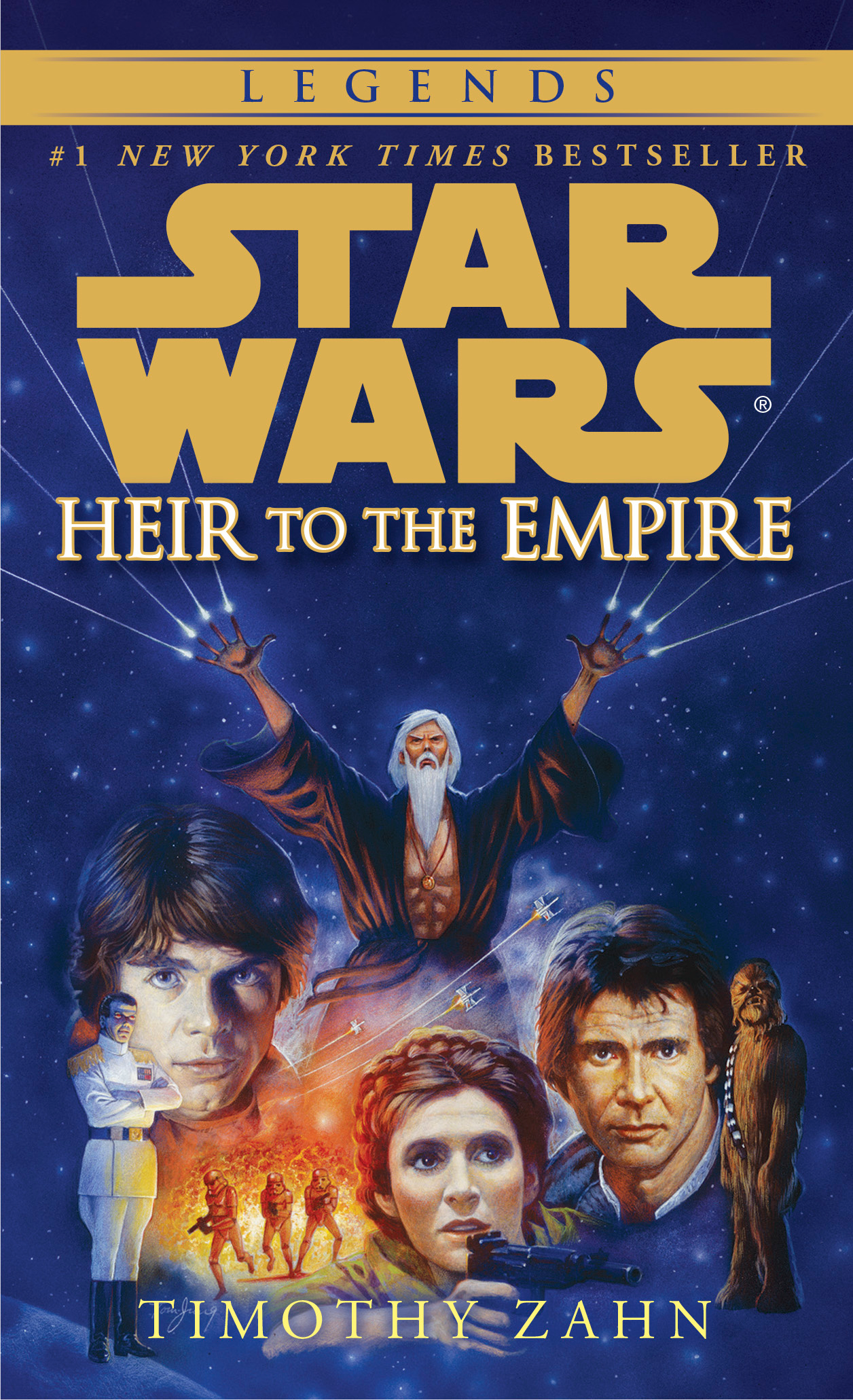
Heir to the Empire Legends cover
Since The Phantom Menace was set in a time of peace, most material that built on The Phantom Menace was set either before or during the film, rather than after.
Attack of the Clones, on the other hand, finally delved into the long-anticipated Clone Wars conflict first mentioned in A New Hope. Attack of the Clones' release led to a massive emergence of new content in Legends, most notable among them are the comic book series, Star Wars: Republic, and a TV micro-series called Star Wars: Clone Wars, both of which built up to the release of Revenge of the Sith. In Star Wars: Clone Wars, produced and directed by Genndy Tartakovsky, many battles of the titular war are shown, with the Force's power displayed in an exaggerated fashion reminiscent of Tartakovsky's previous work. The second season of the series concludes by introducing General Grievous, one of the main antagonists in the upcoming Revenge of the Sith. The third and final season is set in the days leading up until the very beginning of Revenge of the Sith. Meanwhile, Star Wars: Republic supplemented the show, filling in various empty spaces Clone Wars left while providing more context for all three prequel movies.
Following the release of Revenge of the Sith, events between the two trilogies were elaborated upon, such as the Great Jedi Purge. Notable content released in this period that was set between Episodes III and IV include Star Wars: Dark Times, a sequel comic series to Republic that follows in the aftermath of Episode III, as well as the multimedia project Star Wars: The Force Unleashed, which starred Darth Vader's secret apprentice, Galen Marek, and explored the early days of the Rebel Alliance.
On April 25, 2014, Lucasfilm announced that the Expanded Universe was being reorganized under the new non-canon "Star Wars Legends" banner to make way for a new line of continuity, led by principal projects Star Wars Rebels and the Star Wars sequel trilogy, to take shape. Certain previously published Expanded Universe material remained in print as Legends stories. The first novels reprinted under the Legends banner included Heir to the Empire, The Han Solo Adventures, The Lando Calrissian Adventures, Crucible, Kenobi, Razor's Edge, Death Troopers, Fate of the Jedi: Outcast, Maul: Lockdown, Lost Tribe of the Sith: The Collected Stories, and the Star Wars: Lives & Adventures compendium.
While new material released on or after April 25, 2014 is generally considered canon, a certain amount of new material has continued to be released under the Star Wars Legends brand. This has included such material as the concluding comics in the Star Wars comic series by Dark Horse Comics and the final issues of the series Star Wars: Legacy Volume 2 the Star Wars: Rebel Heist miniseries; Star Wars: Darth Maul—Son of Dathomir miniseries (which applies to both Legends and Canon continuities); comic strips published in the concluding volumes of Star Wars Comic UK; early supplements for Fantasy Flight Games' roleplaying system and Star Wars: Imperial Handbook: A Commander's Guide, and tie-in short stories for the video game Star Wars: The Old Republic, which were published online. Most of those, however, ceased publication by the end of 2014.
In 2015, the novella SkyeWalkers: A Clone Wars Story was released on StarWars.com.
On May 29, 2019, the original Star Wars series by Marvel Comics—which is set in the Legends continuity—received a one-shot continuation issue in commemoration of the company's 80th anniversary.
As of 2024, the only new Legends media being continually released is the video game Star Wars: The Old Republic with its constant updates and expansions.
In the era before the Galactic Republic, the Je'daii Order first discovers the Force on the planet Tython, and works to better understand the mystical energy. They struggle to retain balance in the Force, and come into conflict with the marauding Rakata species.
The Old Republic was the government that united the Star Wars galaxy under the rule of the Galactic Senate. In this era, the Jedi are numerous, and serve as guardians of peace and justice. The Tales of the Jedi comics series takes place in this era, chronicling the immense wars fought by the Jedi of old, and the ancient Sith.
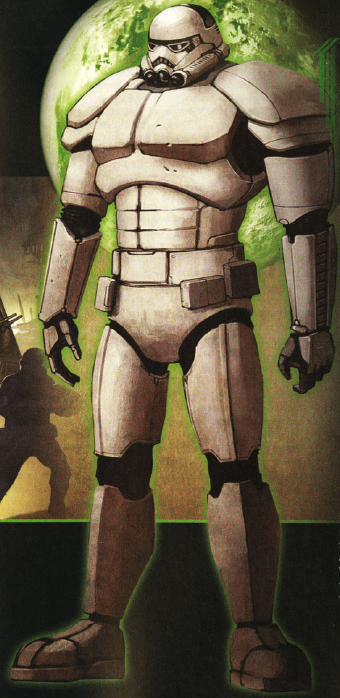
The light spacetrooper is one of the many Legends characters of the Galactic Empire.
After the seemingly final defeat of the Sith, the Republic enters a state of complacency. In the waning years of the Republic, the senate was rife with corruption and scandal, and saddled with a bureaucracy so immense that effective governing was nearly impossible. The ambitious Senator Palpatine caused himself to be elected Supreme Chancellor, and promised to reunite the galaxy under a New Order. The prequel trilogy takes place during this era.
An outcry of resistance begins to spread across the galaxy in protest to the new Empire's tyranny. Cells of Rebellion fight back, and the Galactic Civil War begins. This era begins with the Rebel victory that secured the Death Star plans, and ends a year after the death of the Emperor high over the forest moon of Endor. The Rebellion starts to reform itself into a body of government, first as the Alliance of Free Planets, and later the New Republic. The original trilogy takes place during this era.
Having defeated the Empire at the Battle of Endor, the Rebel Alliance must now transform itself from a militant resistance force into a functioning galactic government. As Imperial territory is reclaimed, the New Republic suffers growing pains, having to fend off insurrections, Imperial loyalists, and wayward warlords. Also, Luke Skywalker, the last of the Jedi, begins training apprentices, rebuilding the Jedi order.
The Jedi Knights are now a hundred strong. The New Republic has signed a peace treaty with what little remains of the Empire. The galaxy is finally enjoying a peaceful respite from decades of war. It's at this time that a horrible alien menace invades the Republic from beyond known space. The Yuuzhan Vong lay waste to entire worlds in their scourge, as depicted in the novels of The New Jedi Order. Five years later the galaxy goes through the events of Star Wars: The Dark Nest Trilogy. The novels detail how Luke Skywalker and his New Jedi Order confront the mysterious insectoid Killiks, who are a hive-minded species intent on conquering the galaxy.
Having reached peace with the Yuuzhan Vong, the newly formed Galactic Federation of Free Alliances struggles to keep itself working as a single government. But many threats from inside are joined by a danger that comes from the remains of the dark side. The new Jedi order created by Luke Skywalker faces a new era as the heirs of the Skywalker legacy grow up. Jacen Solo, perhaps the wisest of that new order, now Ben Skywalker's master, falls to the Dark Side and attempts to create a new empire from the squabbling systems that form the GA. In the Fate of the Jedi series, Luke and Ben travel the galaxy to determine the causes of Jacen's descent into evil, while Abeloth and the Keshiri Sith attempt to take over the galaxy. The Legacy era continues hundreds of years later in a series of comics that debuted in June 2006 entitled Star Wars: Legacy.
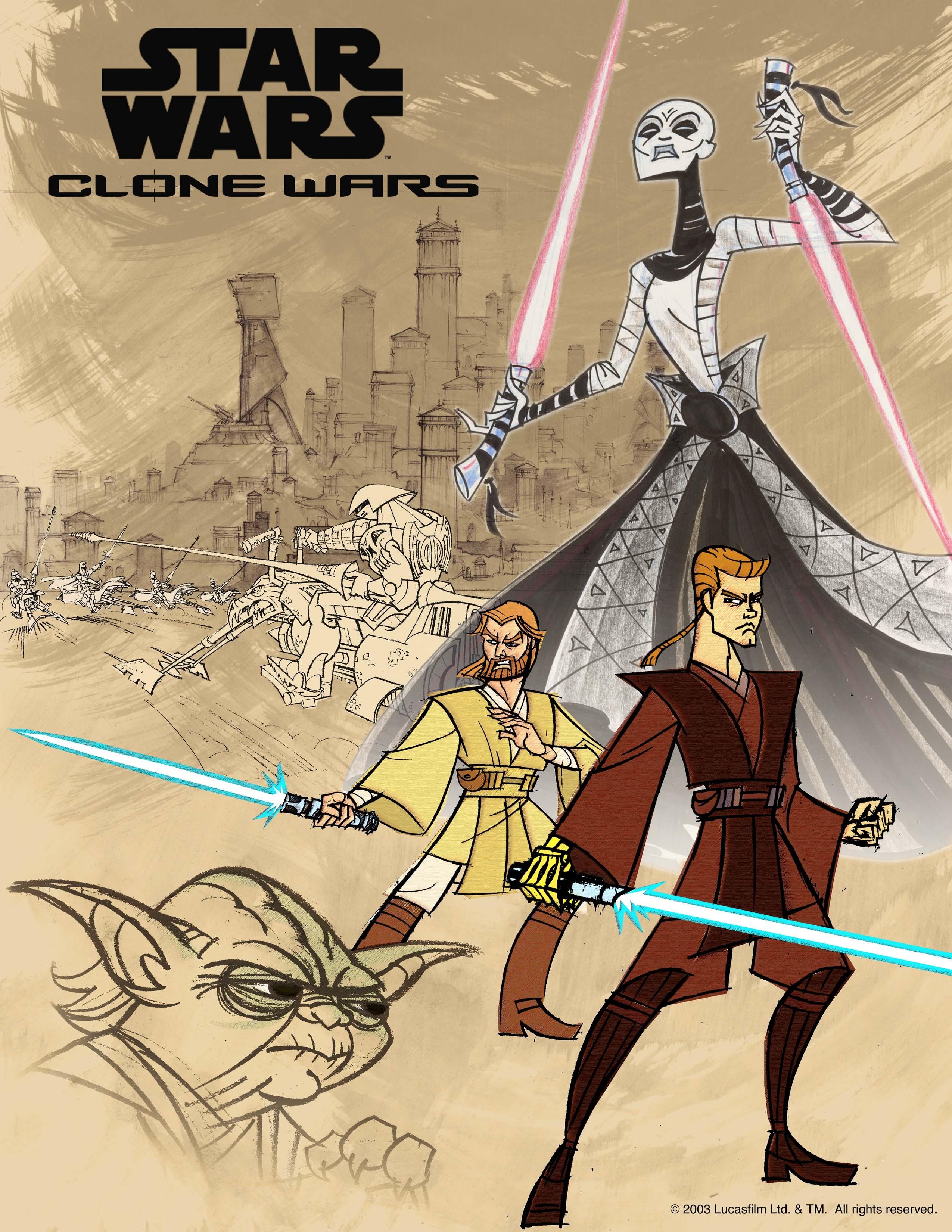
Star Wars: Clone Wars (2003–2005)
- The Star Wars Holiday Special (1978) was a two-hour television special portraying Chewbacca's return to his home planet of Kashyyyk to celebrate Life Day with his family. Along with the stars of the original 1977 movie, such TV and music stars as Beatrice Arthur, Art Carney and Jefferson Starship appeared in plot-related skits and musical numbers. The content was considered canonical within the continuity of the Expanded Universe, but the special is reviled by some fans and virtually disowned by George Lucas, though other fans enjoy its nostalgic sweetness and naively misguided creativity; an online petition for its video release has gotten press in New York Newsday and other media outlets. The Holiday Special features the first appearance of bounty hunterBoba Fett, in an 11-minute animated sequence, and the first reference to Kashyyyk. The general look of the Kashyyyk sets from the Holiday Special formed the basis for the settings used in Revenge of the Sith (2005).
- Caravan of Courage: An Ewok Adventure (1984) was the first of two films featuring the Ewoks from Return of the Jedi. In Caravan of Courage, the Ewoks help two children rescue their parents from a giant known as Gorax. This and the next film are notable for having their stories written by Lucas himself, one of his few contributions to non-theatrical Star Wars productions, other than his obvious sanctioning of them.
- Ewoks: The Battle for Endor (1985). In this second Ewok film, Wicket, Cindel, and the Ewoks ally with a hermit named Noa to defeat Marauders who attacked their village.
- Star Wars: Droids: The Adventures of R2-D2 and C-3PO (1985–1986) was an animated series following the adventures of C-3PO and R2-D2 between Revenge of the Sith and A New Hope. It featured Anthony Daniels as the voice of C-3PO.
- (1985–1987) was an animated series featuring the adventures of the Ewoks prior to Return of the Jedi.
- Star Wars: Clone Wars (2003–2005) aired on the Cartoon Network and depicted events between Attack of the Clones and Revenge of the Sith. The series introduced the characters of GeneralGrievous and Asajj Ventress and received an Emmy Award.
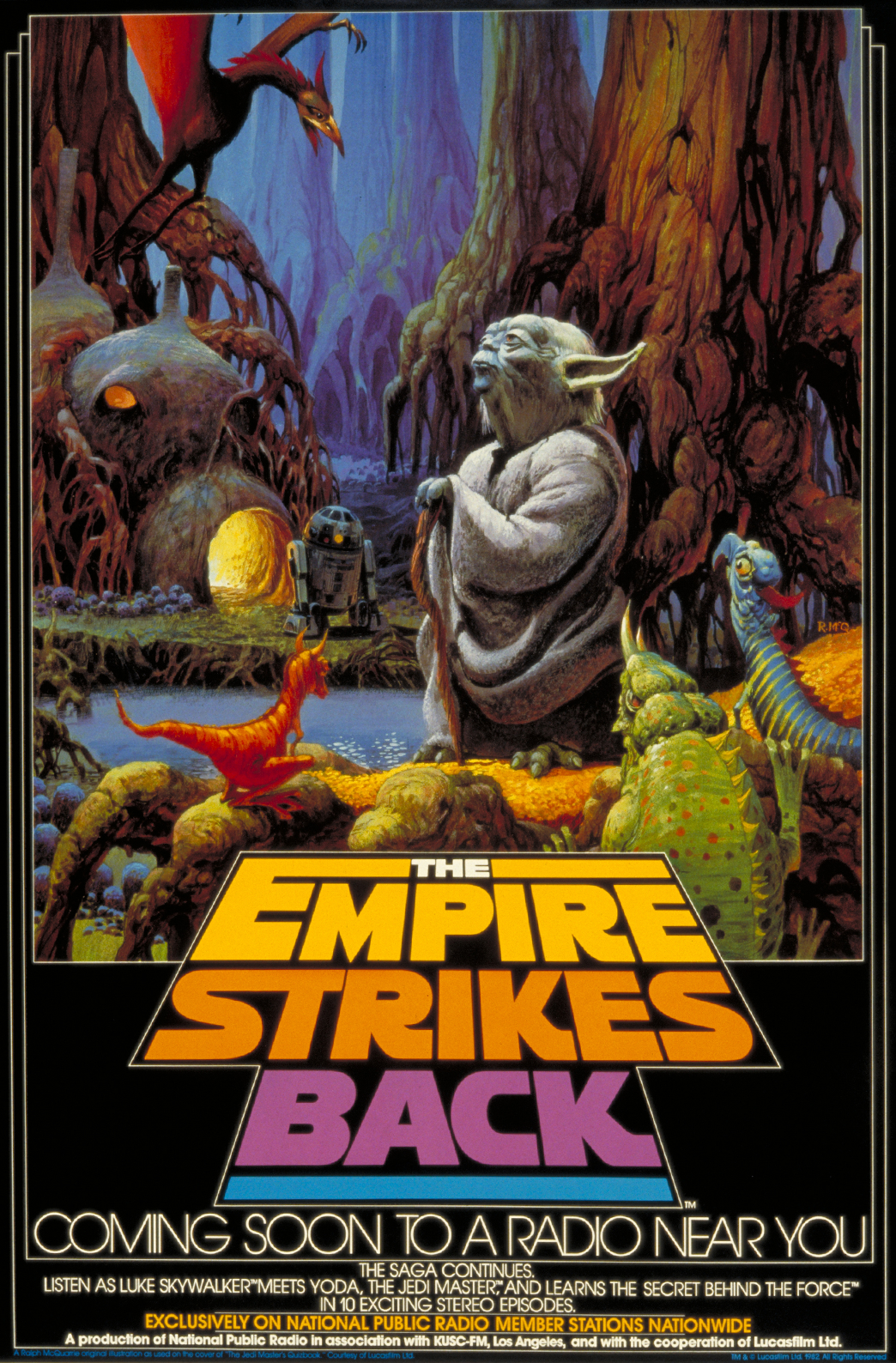
Promotional poster for The Empire Strikes Back radio drama
A radio adaptation of A New Hope was first broadcast on National Public Radio in 1981. The adaptation was written by science fiction author Brian Daley and directed by John Madden, with post-production led by Tom Voegeli. Daley, Madden and Voegeli collaborated to adapt the second installment of the trilogy, The Empire Strikes Back, in 1983. Plans for a radio version of Return of the Jedi had to be scrapped due to federal cuts to NPR's funding.
The radio adaptations were notable for including background material that Lucas cut from the films, as well as original material created by Daley. Mark Hamill, Anthony Daniels, and Billy Dee Williams reprised their roles as Luke Skywalker, C-3PO, and Lando Calrissian, respectively. For the sound mixing, Voegeli had access to all of John Williams's original score and Ben Burtt's sound effect library. He and his assistants recombined these elements of the film in new ways with the recordings of the voice actors.
In 1983, Daley wrote an original Star Wars audio drama, Rebel Mission to Ord Mantell. The drama was produced by Buena Vista Records, which also made the Star Wars Read-Along Adventures. It was performed by most of the same cast as the Read-Along tapes and records.
For more than a decade, Rebel Mission to Ord Mantell was the only Star Wars audio drama not adapted from a feature film. Then, between 1994 and 1999 nearly a dozen audio dramas were released as audio tapes and CDs. These dramas were adapted from comic books, short stories, and video games. They include: Dark Empire and its sequels (1994–1995), Tales of the Jedi and Dark Lords of the Sith (1995), The Band's Tale and The Lovers' Tale (1995), the Dark Forces trilogy (1998), and Crimson Empire (1999). During this same period, HighBridge Audio picked up where NPR had left off, producing a Return of the Jedi radio drama in 1996, which NPR broadcast in November and December.
After this wave, no more Legends audio dramas were made, either adapting the Prequel trilogy or any other era. The next full-cast Star Wars audio dramas were made within the new canon in the 2020s.
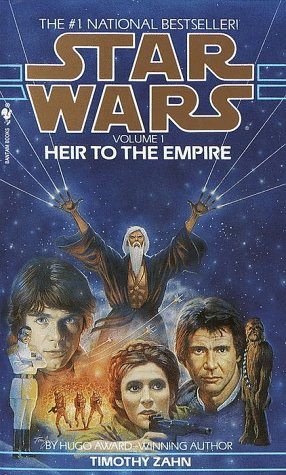
Timothy Zahn's Heir to the Empire, the first volume in the Thrawn Trilogy
Star Wars–based fiction predates the release of the first movie, with the 1976 novelization of A New Hope (ghostwritten by Alan Dean Foster and credited to George Lucas). However, Foster's 1978 novel, Splinter of the Mind's Eye, is thought of as the first Expanded Universe work to be released. In addition to filling in the time between the movies, this additional content greatly expanded the Star Wars timeline before and after the film series.
Star Wars fiction flourished during the time of the original series (1977–1983), but slowed to a trickle afterwards. In 1991, however, Timothy Zahn's celebrated Thrawn Trilogy debuted, sparking a new interest in the Star Wars universe. Since then, several hundred tie-in novels have been published by Bantam Spectra and Del Rey.
Notable books in the series include the X-Wing series by Michael A. Stackpole and Aaron Allston, the Jedi Academy trilogy and Tales From... series by Kevin J. Anderson, and the New Jedi Order series, by various authors. Another notable series of books is the Young Jedi Knights, also by Kevin J. Anderson, which follow the adventures of Jacen and Jaina Solo and their friends. The Legacy series is another important book series, which is written by Aaron Allston, Karen Traviss, and Troy Denning .
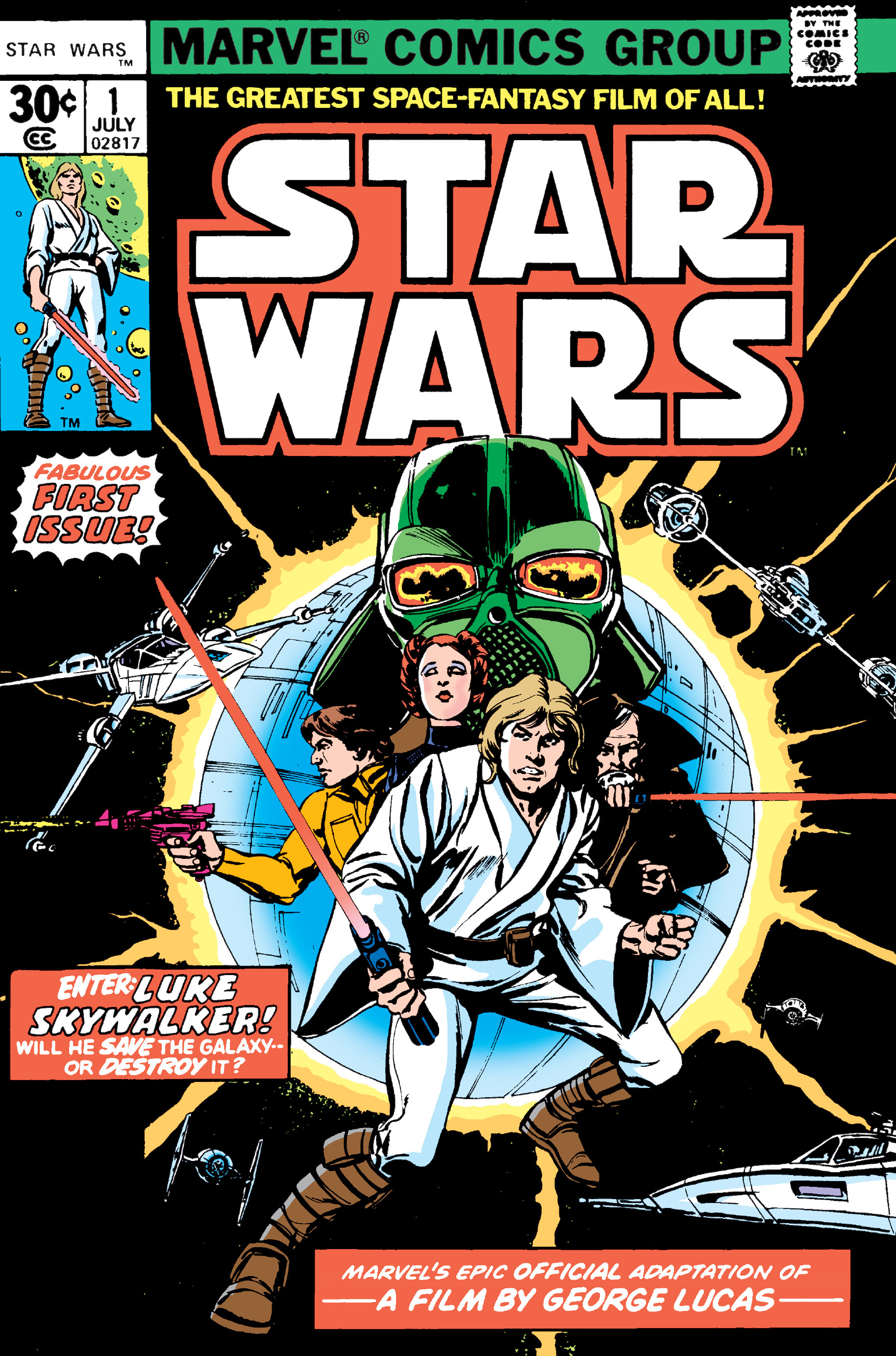
The first issue of the original Marvel series of Star Wars comic books
Marvel Comics published the Star Wars comic-book series and adaptations from 1977 to 1986, and published the first original work in the Expanded Universe with the story The Keeper's World. A wide variety of creators worked on this series, including Archie Goodwin, Howard Chaykin, Al Williamson, Carmine Infantino, Gene Day, Walter Simonson, Michael Golden, Chris Claremont, Whilce Portacio, Mary Jo Duffy, and Ron Frenz.
In the 1980s, as part of its Star Comics line aimed at young children, Marvel published the short-lived series Ewoks and Droids, based on the two Saturday-morning cartoons of the same name.
Star Wars was also a daily newspaper comic strip from 1979 to 1984. Among the creators were Goodwin, Williamson, and Russ Manning.
In the late 1980s, Marvel announced it would publish a new Star Wars comic by Tom Veitch and Cam Kennedy. However, Dark Horse Comics published Dark Empire instead, and went on to publish a large number of original adventures set in the Star Wars universe. These include Star Wars: Republic, Star Wars Empire, Star Wars Tales and Star Wars: Tales of the Jedi. Dark Horse has also republished the Marvel series and newspaper strips in a collection entitled Classic Star Wars. In addition, the company has reprinted several Japanese manga interpretations of the films, including Star Wars Manga: The Empire Strikes Back by Toshiki Kudo and Star Wars Manga: Return of the Jedi by Shin-Ichi Hiromoto.

Star Wars: Knights of the Old Republic PC box cover
Since 1983, over 120 video games have been published bearing the Star Wars name, beginning with Star Wars: The Empire Strikes Back published for the Atari 2600 by Parker Brothers. Other early titles include the Star Wars Nintendo Entertainment System game (published by JVC) and three other titles for the Atari 2600.
Atari produced arcade games based on the original trilogy, beginning with Star Wars and The Empire Strikes Back, which were both "flight sim" style games that utilized vector graphics. The third, Return of the Jedi, used more traditional raster graphics.
Star Wars has also, not surprisingly, opened the way to a myriad of space-flight simulations that take the space wars of the saga more seriously, teaching the player to fly various Star Wars starfighters along the lines of more traditional "Modern Aircraft" flight simulators. The first among these were "X-Wing" and its two expansions, "B-Wing" and "Imperial Pursuit," dealing with the Rebellion's side of the war, taking place in the period right before, and up to, the destruction of the first Death Star. The second was "TIE Fighter," dealing with the Empire's starfighters at the time prior to Episode VI. Both games were released for DOS and Macintosh. "TIE Fighter" had an expansion disk, "Defender of the Empire." In addition, both the original "X-Wing" and "TIE Fighter" games saw two collector's edition releases (one for DOS and another for Windows 9x) which featured enhanced graphics quality and added missions. Newer simulators are also available, with Star Wars: X-Wing Alliance in the lead.
The first Star Wars first-person shooter, Dark Forces, was introduced by LucasArts in February 1995. Telling the story of Kyle Katarn, Imperial soldier turned mercenary, the game featured a little over a dozen levels where the player explored various original and familiar settings. Featuring an original and interactive soundtrack by game composer Clint Bajakian using the iMUSE sound system, along with state-of-the-art graphics, the game succeeded in capturing many gamers' imaginations. The 1997 sequel, Star Wars: Jedi Knight: Dark Forces II, was notable for having a few cut scenes which were made up of live-action footage of certain Expanded Universe characters, such as Kyle Katarn. It had 2 other sequels named Star Wars: Jedi Knight II: Jedi Outcast and Star Wars: Jedi Knight: Jedi Academy, that incorporated a new system of lightsaber combat and received re-releases years later.
Rogue Squadron was a cross-platform title on Nintendo 64 and PC which allowed the player to experience a more arcade-action version of the same gameplay in X-Wing and TIE Fighter, similar to the action in the Nintendo 64 title Shadows of the Empire. The game consisted of piloting several different Star Wars vehicles through missions on planet surfaces and in space. Rogue Squadron saw two sequels, both on the Nintendo GameCube system.
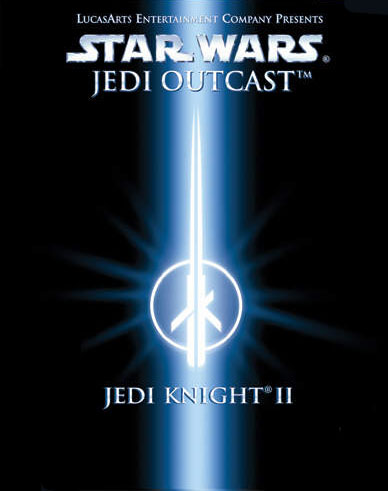
Star Wars: Jedi Knight II: Jedi Outcast PC Box Cover Art.
Star Wars: Rebellion allowed players to compete in the Star Wars universe on a larger scale, focusing more on the strategic aspect of handling (or defeating) a rebellion, with resource management and agent allocation, as well as large-scale conflicts between entire fleets of starships.
Knights of the Old Republic by BioWare and Knights of the Old Republic II: The Sith Lords by Obsidian Entertainment are recent additions to the EU, and take place in the Old Republic era, right after the Mandalorian wars. The games are of the action role-playing game (RPG) genre, a type of RPG that is still turn based like most RPGs, but instead of waiting for the other player to take a turn, the turns are based on a rate of fire. This style of RPG is somewhat new and made big waves for its innovative style.
Other games are Battlefront, Battlefront II, Star Wars Battlefront: Renegade Squadron, Galactic Battlegrounds, Republic Commando, Episode III: The video game, LEGO Star Wars, Jedi Outcast, Jedi Academy, Star Wars Galaxies: An Empire Divided, The Force Unleashed, The Force Unleashed II, and Empire at War.
In a 1996 game from Hasbro Inc., entitled Star Wars: The Interactive Video Board Game, which is set during the era of the original trilogy, new live-action scenes were shot of Darth Vader on the Death Star around the events of Return of the Jedi. The footage was made available on a special VHS tape, included in the box of the game. When playing the board game, the players could put in the tape, which would play while they were in a game. David Prowse reprises his role as Vader, and James Earl Jones returned as the voice of Vader. Some of the original crew for A New Hope came back to shoot these scenes.
Several editions of the Star Wars roleplaying games have been published. The first edition (a d6 version) was published by West End Games in 1987. The second edition was published by West End Games in 1992. The 2.5 edition was published by West End Games in 1996. In late 2000, Wizards of the Coast released the third edition (a d20 version). In 2002, Wizards of the Coast released the 3.5 edition. Bill Slavicsek worked on all the editions. He included a conversion table (from the previous d6 versions to the new d20 version) at the end of the third edition that helped Star Wars gamers adapt to the new d20 version. In 2007, Wizards of the Coast released the Saga Edition Rulebook, which offers a revised d20 system for players to develop their characters and take advantage of the vast number of miniatures that Wizards produces. In 2010, Wizards of the Coast announced that they would not be renewing their license to produce new Star Wars material after the third quarter of that year.
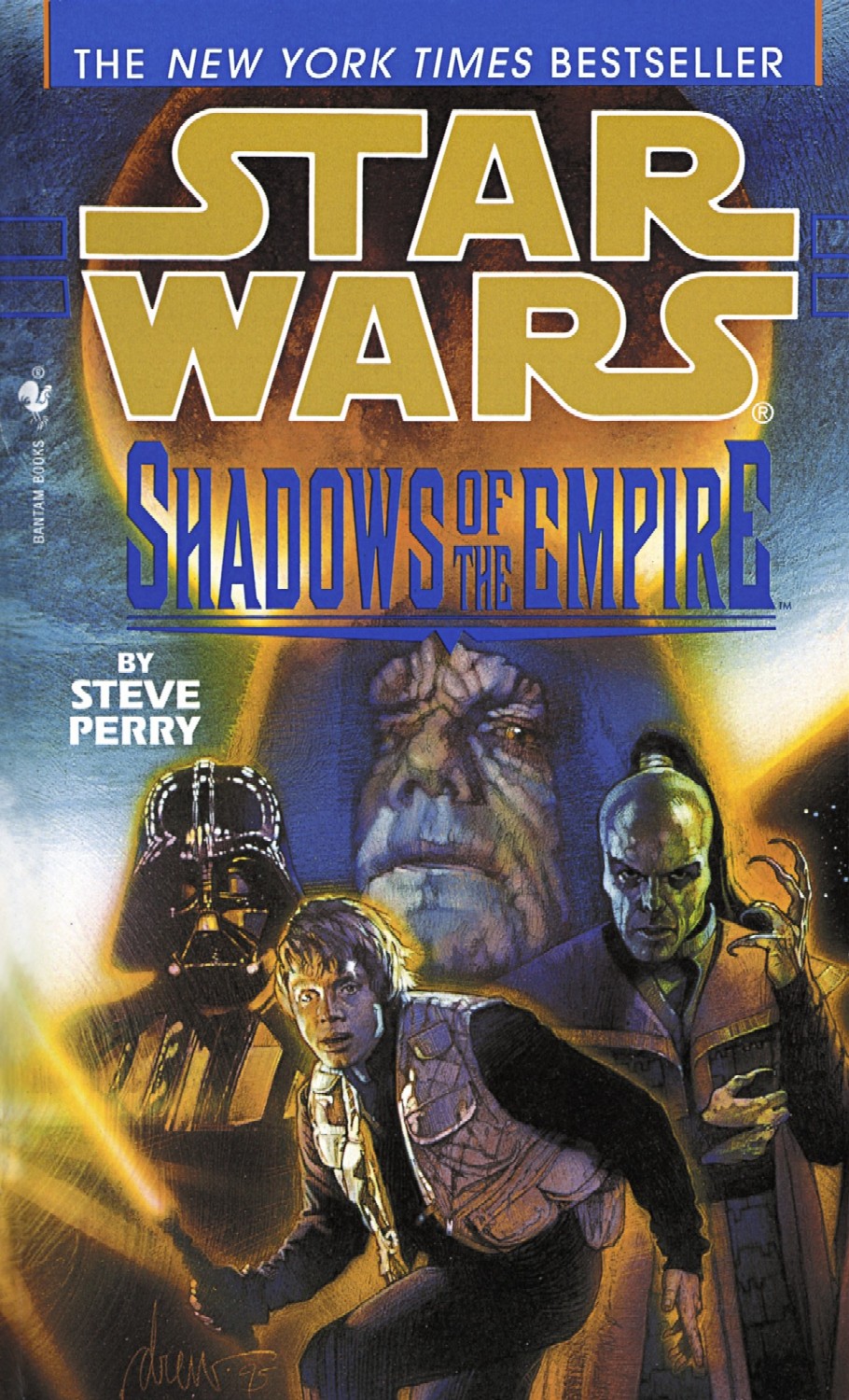
The Shadows of the Empire multimedia project was set between the events of The Empire Strikes Back and Return of the Jedi.
In 2005, Hasbro developed and released a DVD TV game based on Star Wars and utilizing the Trivial Pursuit game-play format.
In 2012, new license holders Fantasy Flight Games released their Star Wars: X-Wing Miniatures Game miniature space combat game and Living Card Game.
- Star Wars: Shadows of the Empire (1996) was an ambitious multimedia project created by Lucasfilm. Dubbed "a film without a film," Shadows of the Empire told the story of the events between The Empire Strikes Back and Return of the Jedi, and introduced a new villain, the crime lord Prince Xizor. Utilizing all previous types of media that have been used to present the Expanded Universe, the project included a novel written by Steve Perry, multiple comic book series, a soundtrack, a video game, concept art, action figures, and the like.
- Clone Wars (2003–2005). Using methods similar to the Shadows of the Empire project, Lucasfilm directed a widespread project to tell the stories of the Clone Wars. This project was made up of films, novels, video games, comics, action figures, and even its own animated series (described above).
- The Force Unleashed (2008). Originally set for 2007, production was postponed for a year. Set between the two trilogies and during the Great Jedi Purge, it focuses on the adventures of Darth Vader's secret apprentice, Galen Marek. It's been referred to as "the next chapter in the Star Wars saga." Like its predecessors, it includes novels, comics, a game, roleplaying-game resources, and more.
- Return of the Ewok (1982) was a 24-minute fictional mockumentary-style movie, focusing on Warwick Davis' decision to become an actor and act as Wicket in Return of the Jedi.
- R2-D2: Beneath the Dome (2002) was a 20-minute mockumentary-style movie, focusing on the "true" story of R2-D2's life. It was made as a fun side project by some of the crew of Star Wars Episode II: Attack of the Clones, but was later deemed suitable for television and for its own DVD.
In 1987, Lucasfilm and Disney, utilizing the power of Industrial Light & Magic, teamed up to produce Star Tours, an amusement-park simulator ride through the Star Wars galaxy, eventually opened in multiple Disney parks. The ride is advertised as an opportunity to take a tour to the forest moon of Endor via the StarSpeeder 3000. The ship is controlled by a robot named Rex (voiced by Paul Reubens of Pee-wee Herman fame), who is new at giving the tours, and your riding experience happens to be his first time at the controls. Along the way, the rider encounters many mishaps, including run-ins with Imperial Star Destroyers and near collisions with icy comets, until the ship finally makes it safely into the port.
George Lucas and Disney announced an updated version of the attraction, known as Star Tours: The Adventures Continue, set between Episodes III and IV. The new ride opened May 20, 2011 in Disney's Hollywood Studios and June 3, 2011 in Disneyland. A limited-run line of action figures is also available exclusively in the Star Tours gift shop, based on droid characters from the ride and the attraction queue.
In addition, many other toys have been made. The Star Wars toy phenomenon began in 1978 with the original action figures, toy lightsabers and blasters, twelve-inch figures, toy vehicles, and many more products. These toys are known as the vintage Star Wars toys. Today, many of these "vintage" figures are quite rare. Many are also worth a lot of money. Recently, a toy line called Star Wars: The Original Trilogy Collection brought back elements of the original vintage toy line, such as vintage packaging. With the coming of The Phantom Menace, LEGO began creating buildable Star Wars characters and scenes. A few years ago, the LEGO creators invented light-up lightsabers for their figures. These lightsabers are no longer used. LEGO has cooperated with LucasArts to make four video games (LEGO Star Wars 1, 2, 3 and Complete Saga).
Many types of toys have been made. Darth Vader helmets and voice changers now inhabit the shelves, usually right next to the Ultimate Lightsaber Kit, which contains parts to design and assemble your own functional lightsaber toy. The term "Expanded Universe" was first used with Kenner's assortments of action figures based on the various Star Wars novels, comic books, and video games. Previous toys based on novels were sold by Galoob as "Epic Collections."
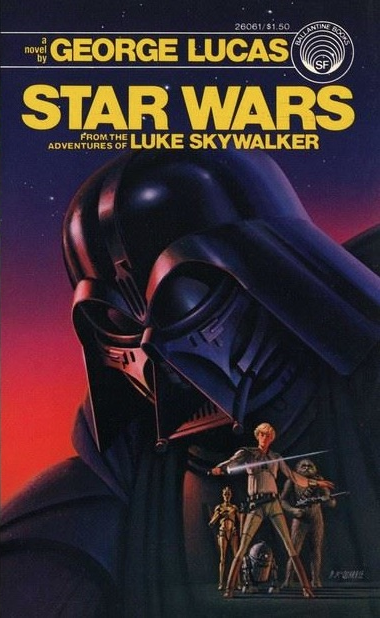
Star Wars - 1976 first printing
The Expanded Universe was intended to be a continuation, and an expansion, on the six Star Wars theatrical films produced by George Lucas from 1977 to 2005. All Legends material, combined with that presented in the films, was meant to function as a complete story. However, in order to allow this story to function as a whole, it was kept in an order of continuity. Lucasfilm held this of such high importance that a team's sole job at Lucasfilm was maintaining continuity between Lucas's films and the Legends, which was created by many other authors and artists, many times out of order, and with many different ideas. Lucas, while supporting the works of the EU, nevertheless told the stories he wished to in his films, which sometimes contradicted material previously seen in the EU. When asked in an interview his general opinion on the EU, he replied:
During his time heading Lucasfilm, Lucas retained ultimate creative control over the Star Wars universe. For example, the "death" of central characters and similar changes in the status quo were required to first pass his screening before authors were given the go-ahead. In addition, Lucasfilm Licensing devoted considerable effort to ensure continuity between the works of various authors across multiple companies. Nothing in the Expanded Universe was supposed to contradict the films or any other part of the Expanded Universe. Upon occasion, Lucas's new films, reedited original-trilogy films, or statements contradicted existing EU material, and several retcons were used to fix these inconsistencies.
Some purists rejected the Expanded Universe as apocrypha, believing that only the events in the film series are part of the "real" Star Wars universe. (Palpatine's clones, for example, seem to contradict the "chosen one" theory.) This line of thought was supported to the extent that some Expanded Universe material released before Lucas's prequel films drew conclusions that Lucas later overturned. However, elements of the Expanded Universe were adopted by Lucas for use in the films. For example, the name of planet Coruscant first appeared in Timothy Zahn's novel Heir to the Empire before being used in the prequel trilogy (with a different pronunciation)—though the planet itself, under a different name, had existed in a previous version of the Return of the Jedi script. Also, the Twi'lek Jedi Aayla Secura originally appeared in the ongoing Dark Horse comics series Republic; apparently Lucas saw the cover which featured her and liked the look of her character so much that he included her in the Jedi battle at the end of Attack of the Clones, played by Lucasfilm employee Amy Allen, and her demise is later shown in Revenge of the Sith. These examples sometimes ended up confusing the issue, having blurred the lines between the Expanded Universe and "his world."
This was a hotly debated issue among Star Wars fans. Superficially, one allure of the films is that they are organized numerically and logically whereas the Expanded Universe was published out of chronological sequence and occasionally contained minor contradictions and in some cases even major discrepancies, despite the best efforts of Lucas Licensing. On the other hand, the Expanded Universe provided depth to the world of Star Wars. Some readers accused the EU sources of being excessively self-referential, to an extent that misrepresents the Star Wars universe (e.g., EU minimalism, the creeping reduction of technological abilities and physical scope in EU sources). Some other fans found that the Expanded Universe convention destroyed many of the good dramatic elements of the movies by explaining things in a way they find unfavorable. These critics felt that writing a new story within the context of the EU handcuffs the author.
In theory, the films were the absolute canon and everything else official was part of the Expanded Universe that, while generally valid, could not contradict anything in the movies. Wherever an EU source contradicted movie canon, the EU source was invalid on that specific point, though the rest of the source was still considered part of the continuity. Despite the unpopularity of works like the Jedi Prince series, they were considered just as canonical as popular works like Star Wars: Shadows of the Empire, to the degree that they were not contradicted by material from a higher "canon tier," later work, or some other statement from an official source declaring them to be non-canon.
However, this sometimes did not appear to be true in practice. For example, Prophets of the Dark Side featured the wedding of Han Solo and Princess Leia, but Dave Wolverton ignored this and featured the same event in his novel The Courtship of Princess Leia, which was released a few years later. According to the rules of the Expanded Universe, both versions were within continuity, though it was the wedding in Dave Wolverton's book that is most often referenced. Fans tried to fix this problem by suggesting that, since the scene in Prophets of the Dark Side concludes just as Han and Leia are walking down the aisle, the event was disrupted and postponed until the time of The Courtship of Princess Leia; the authors of Prophets of the Dark Side confirmed that they had planned to write another series of novels which would begin with the wedding's disruption, but their contract was cancelled before they could do so.
There were also minor disputes about what was, and what was not, part of the Expanded Universe. For example, the spin-off films: Caravan of Courage: An Ewok Adventure and Ewoks: The Battle for Endor were written by George Lucas and are films, but neither of them is one of the six main films in the series, so they were usually considered a part of the Expanded Universe. Both films were later officially confirmed as part of the continuity of Star Wars Legends and no longer canon.
The original Star Wars Databank entries distinguished movie information and EU information, providing them in separate tabs.
As of April 25, 2014, no material originating purely from an Expanded Universe source is considered canon. In order to be considered canon, the material must have appeared within one of the Star Wars films from the original trilogy or prequel trilogy, the Star Wars: The Clone Wars television series or its associated film, or most material released on or after April 25, 2014. While such material often features material originating from the Expanded Universe, only the details featured within the new material are considered canon. For example, while "spicebrew" appears in both material from the old Expanded Universe and the new canon continuity, one cannot assume that the drink is part of the mixture that makes a Sonic Servodriver, these details being provided only in a Legends source.
The Holocron continuity database was an internal database maintained by Lucas Licensing for the express purpose of trying to maintain continuity. This database was sorted into five levels that reflected LFL's canon and continuity policies: G, T, C, S, and N. All levels with the exception of N formed an overall continuity that was considered by Lucasfilm to be the "true" Star Wars canon prior to the rebranding of the Expanded Universe to Legends in April of 2014.
- (George Lucas) canon was absolute canon. This category included the six films, some of the deleted scenes from the films, the novelizations of the films, the radio dramas based on the films, the film scripts, and any material found in any other source (published or not) that comes directly from George Lucas himself. G canon overruled all other forms of canon when there was a contradiction.
- canon referred to the canon level comprising only the television show Star Wars: The Clone Wars.
- (continuity) canon referred to the main body of EU work, and was the next most authoritative level of canon. All material published under the Star Wars label but not falling into G, S, or N was C canon, and was considered authoritative as long as not contradicted by G canon. Games were a special case as generally only the stories would be C-canon while things like stats and gameplay were N-canon. If the video game had several possible endings or if the player could choose the gender or the species of the main character, only one of each is considered C-canon. C-canon elements have appeared in the movies, thus making them G-canon. These included Coruscant (both its name and the concept of it being an ecumenopolis), swoop bikes, Aayla Secura, Double Bladed Lightsabers, YT-2400 freighters, and Action VI transports.
- (secondary) canon referred to older, less accurate, or less coherent EU works, which would not ordinarily fit in the main continuity of G and C canon. Unless referenced by a G- or C-level source, the story itself is considered non-continuity, but the non-contradicting elements were still a canon part of the Star Wars universe. For example, this included The Star Wars Holiday Special, the Marvel comics, the popular online roleplaying game Star Wars Galaxies, and certain elements of a few N-canon stories.
- continuity material is also known as "non-canon" or "non-continuity" material. What-if stories (such as those published under the Infinities label), game stats, "comic" material such as Angry Birds Star Wars or Jedi Academy and anything else that was directly contradicted by higher canon and could not at all fit into continuity was placed into this category. N-canon was the only level that was not at all considered canon by Lucasfilm.
C-canon elements from licensed creators have appeared in Lucas's films. Most of these are brief, cameo appearances, almost taking the form of Easter eggs (which may have been added by animators or others under Lucas, rather than specifically dictated), but others are more substantial. While Lucas viewed Legends as separate from his story, he took inspiration from it or borrowed certain elements and characters for his films.
- The name of the Wookiee home planet Kashyyyk was taken from Legends, although Lucas himself invented the species and the planet. Concept artists viewed The Star Wars Holiday Special multiple times while designing the Kashyyyk environment for Revenge of the Sith.
- George Lucas adopted the name "Coruscant" for the capital planet of the Galactic Republic, previously known as Had Abbadon in his drafts.
- Fascinated by her depiction in cover art for a comic by Jan Duursema , Lucas adopted the character Aayla Secura for Star Wars: Episode II Attack of the Clones. He also adopted the Expanded Universe name "Twi'lek" for Secura's species, as evidenced by a remark of his which is documented in an Episode III Set Diary entry.
- The Legends character Tsui Choi was at one point slated to appear in Revenge of the Sith.
- Artists for the prequel films have used various Expanded Universe materials—particularly the Star Wars: Chronicles and Incredible Cross-Sections books—as inspiration for their work on the prequel films.
In August 2009, Mixnmojo made an interview with , LucasArts' Vice President of Global Publishing back in 2009. It's worth to highlight the following part from the interview:
Lucas has often worked very closely with Legends creators:
- Lucas met with Roy Thomas to help plan the early storylines for Marvel's Star Wars, and personally approved the direction Thomas planned to take the series.
- Lucas selected Archie Goodwin to become a writer for the Star Wars comic strip.
- Lucas was involved in the writing of the script's first draft for The Star Wars Holiday Special with the Smith-Hemion productions.
- Lucas wrote the stories for, executive produced, and directed pick-ups and re-shoots for both of the Ewok films from the mid-eighties, Caravan of Courage and The Battle for Endor.
- Lucas was involved with the creation of the Star Tours theme park attraction.
- During the production of the Shadows of the Empire multimedia project, Lucas instructed those involved to base the PrinceXizor character on the Dashade species from The Star Wars Holiday Special.
- Kevin J. Anderson developed the process of Jedi training for the Jedi Academy trilogy based on Lucas' input and memos.
- When asked about it, Lucas approved Kevin J. Anderson's idea of killing off the character of Crix Madine in the novel Darksaber.
- Lucas helped Tom Veitch and Kevin J. Anderson to develop aspects of the Jedi and Sith for the Tales of the Jedi comics by answering questionnaires and approving/vetoing ideas.
- When Terry Brooks was writing the novelization of The Phantom Menace, Lucas informed him of the extensive history of the Sith and Jedi before that time period, so he could include it in his book. For example, the character of Darth Bane is an original creation of Lucas', and although he did not include information on the character in his films, he informed Terry Brooks of the character to incorporate into the novelization. Lucas also gave Brooks other extensive bits of info of what went on during The Phantom Menace.
- Lucas wrote the prologue for Matthew Stover's novel Shatterpoint.
- Lucas gave Genndy Tartakovsky information on specific events during the Clone Wars, which Tartakovsky used in part of the series Star Wars: Clone Wars.
- James Luceno based his book Labyrinth of Evil on the background Lucas informed him of, of what happened right before Revenge of the Sith. Lucas also allowed him to explore the backstory of Sifo-Dyas and the mystery behind Kamino's erasure from the Jedi Archives, two plot points he originally intended to reveal in Revenge of the Sith.
- Lucas decided that Delta Squad should have colored armor in Star Wars: Republic Commando, to match Episode III.
- Lucas instructed John Ostrander on the fate of Quinlan Vos in Republic 83.
- Lucas decreed that there could be no more Wookiee Jedi in the Expanded Universe. Notably, Obsidian Entertainment was forbidden to make Hanharr a Dark Jedi because of this restriction.
- Lucas decreed that, following Episode III, Palpatine has only minor concern over the remaining Jedi.
- Lucas owns the original cover art of Tag & Bink Were Here.
- Lucas gave his direct input and guidance to the 2007 multimedia project Star Wars: The Force Unleashed.
- Lucas established that Darth Plagueis is a Muun.
On the other hand, Lucas and authors of the Expanded Universe mostly worked independently from each other. This resulted that the Expanded Universe often deviated from his vision. Examples of inconsistencies include:
- Opposed to the thousand years old struggle between Jedi and Sith depicted in the Expanded Universe, George Lucas stated that there was never a war between them.
- George Lucas stated that events of the Expanded Universe following Return of the Jedi "isn't at all what I would have done with it", stating that the "Emperor doesn't get cloned and Luke doesn't get married".
- The deaths of Obi-Wan, Yoda, and Anakin Skywalker in the original trilogy made it appear that dead Jedi typically disappeared and reappeared as Force ghosts. Revenge of the Sith revealed that this is in fact a very rare ability only a few Jedi have ever mastered. The 2007 Star Wars: Legacy of the Force novel Sacrifice further reveals that a Jedi can choose to become one with the Force or to have the body left behind. While the C-canon presented several Sith spirits, George Lucas stated that preserving identity after death only can be achieved via the light side of the Force.
- Boba Fett's origins originally named him as Jaster Mereel, a Journeyman Protector exiled from Concord Dawn. It was later revealed that Jaster Mereel was merely an alias Fett was using when he was exiled. The real Jaster, whose name Boba used as an alias, was retconned into a separate character. In the Expanded Universe, Boba Fett and his father, Jango presented as Mandalorians, whereas, according to Lucas, they were in fact, not Mandalorians, just wearing Mandalorian armor.
- The portrayal of Mandalorian culture and the planet Mandalore is significantly different in the Expanded Universe and in the 2008 Clone Wars Tv show.
- The Clone Wars as described in Zahn's Thrawn trilogy were, at least in part, a struggle between the Old Republic and an army of insane clones grown and controlled by a number of "clonemasters." Attack of the Clones, on the other hand, revealed that the Clone Wars were fought between the Old Republic (using clones) and a (single) Separatist movement (using droids). When writing the prequel trilogy, Lucas changed the dates he had originally given Zahn for the Clone Wars, so Zahn's estimate was at least a decade off. This inconsistency was easily retconned, however, since it was the Noghri who gave the former date, and this species was using their own unique dating system.
- In Revenge of the Sith, Anakin is outraged that he was admitted to the Jedi Council but not given the rank of master. He says that such an occurrence had never happened in the history of the order. However, it had been established that during the time of The Phantom Menace, Ki-Adi-Mundi was a council member though he was only a knight. This may be less an inconsistency than mere hyperbole if Anakin knew that it was a rare but not unheard-of occurrence, or it may indicate that his knowledge of the order's history was incomplete.
- The backstory of General Grievous presented in the Expanded Universe is significantly different from George Lucas' vision of the character.
- R4-P17, the droid in Obi-Wan's Jedi Starfighter in Attack of the Clones, is at first an incorrect designation, as it has the dome of an R2 unit. The R4's dome is more conical. However, this was retconned by saying that R4-P17's old R4 body was damaged, and its remains were placed in an R2 body.
On a number of occasions, cast and crew from the films have been known to participate in the EU.
- George Lucas has worked quite a bit with the EU.
- Mark Hamill reprised his role as Luke Skywalker for The Star Wars Holiday Special (1978), as well as for a brief voice role as Luke in the 2000television commercial for the novel Vector Prime. He also worked on the LEGO Star Wars: Revenge of the Brick animated short and for the first two dramatizations of the early-1980s Star Wars radio drama.
- Harrison Ford reprised his role as Han Solo for The Star Wars Holiday Special.
- Carrie Fisher reprised her role as PrincessLeia Organa for The Star Wars Holiday Special.
- Peter Mayhew reprised his role as Chewbacca for The Star Wars Holiday Special, and wrote the introduction for the Chewbacca trade paperback.
- Archive footage of Samuel L. Jackson is used for the video-game adaptation of Star Wars Episode III.
- David Prowse and James Earl Jones reprised their role as the body and voice (respectively) of Darth Vader for The Star Wars Holiday Special and Star Wars: The Interactive Video Board Game.
- Anthony Daniels has portrayed C-3PO in all of his non-film roles where 3PO either physically appeared, or needed the voice work (with the exception of the Dark Empire audio dramas), and co-wrote Star Wars Droids: The Protocol Offensive. According to Genndy Tartakovsky, Daniels also rewrote some of his lines while working on the Star Wars: Clone Wars animated series so that they would be more like what his character would normally say.
- Liam Neeson reprised his role as Qui-Gon Jinn for LEGO Star Wars: The Video Game.
- Billy Dee Williams reprised his role as Lando Calrissian for The Empire Strikes Back audio drama and the Dark Empire audio drama, as well as the video games Star Wars: Jedi Knight II: Jedi Outcast, Star Wars: Battlefront II, and LEGO Star Wars II: The Original Trilogy.
- Warwick Davis reprised his role as Wicket W. Warrick in the two Ewok films Caravan of Courage: An Ewok Adventure (1984) and Ewoks: The Battle for Endor (1985), and his non-canon film Return of the Ewok. He also portrayed Willow Ufgood in the retroactively non-canon film, Willow (1988).
- Lewis MacLeod reprised his role as Sebulba for all of his video-game appearances as well as playing Obi-Wan Kenobi in the video games Star Wars: Super Bombad Racing, Star Wars: Galactic Battlegrounds and Star Wars: Obi-Wan.
- Ian McDiarmid reprised his role as Darth Sidious for the video game Star Wars Battlefront: Elite Squadron
- Alethea McGrath reprises her role as Jocasta Nu in the video-game adaptation of Star Wars Episode III.
- Temuera Morrison reprised his role as Jango Fett in the video games Star Wars: Bounty Hunter, Star Wars: Battlefront, Star Wars: Battlefront II, and Star Wars Battlefront: Elite Squadron. He reprised his voice role as Boba Fett in the video games Star Wars: Battlefront II, Star Wars Battlefront: Elite Squadron, and Star Wars: Empire at War. Additionally, he reprised his roles as various clone troopers in the video games Star Wars: Battlefront, Star Wars: Republic Commando, Star Wars: Battlefront II, and Star Wars Battlefront: Elite Squadron. Archive sounds of Morrison were used for the voice of Jango Fett and various clone troopers in LEGO Star Wars: The Video Game.
- Jake Lloyd reprised his role as Anakin Skywalker in the video games Star Wars: Episode I The Phantom Menace video game, Star Wars: Episode I Racer, Star Wars: Episode I Jedi Power Battles, Star Wars: Galactic Battlegrounds, Star Wars: Super Bombad Racing, and Star Wars: Racer Revenge.
- Andrew Secombe reprised his role of Watto for all of the character's video-game appearances.
- Denis Lawson, who portrayed Wedge Antilles in all three films of the original trilogy, reprised the role, in voice-over form, in the Nintendo GameCube game Star Wars: Rogue Squadron II: Rogue Leader and the audio books Heir to the Empire and Dark Force Rising, as well as providing narration and voice-over work for all characters including Wedge Antilles.
- Voice actor Matthew Wood, who played GeneralGrievous in Revenge of the Sith, reprised his role as the character in speaking roles for the Revenge of the Sith video game, the Star Wars: Battlefront II video game, and the General Grievous Halloween audiocast.
- Corey Burton, who provided the voice of Rebel pilot Hobbie in The Empire Strikes Back, played several voice roles in the Expanded Universe.
- Clive Revill, who provided the original voice for EmperorPalpatine in The Empire Strikes Back, provided the voice for Jan Dodonna in the Star Wars: X-Wing Collector's Edition.
- Ahmed Best reprised his role as Jar Jar Binks in the video games Star Wars Episode I: The Gungan Frontier, Star Wars Episode I: The Phantom Menace video game, Star Wars: Episode I Jedi Power Battles, Star Wars: Super Bombad Racing, and Star Wars: Galactic Battlegrounds, as well as an episode of Star Wars: The Clone Wars.
- Greg Proops reprised his role as Fode in Star Wars: Episode I Racer. He also played the character of Tal Merrik in The Clone WarsSeason Two episodes "The Mandalore Plot" and "Voyage of Temptation."
- Leeanna Walsman, who played Zam Wesell in Attack of the Clones, reprised her role via voice in Star Wars: Bounty Hunter.
- Ben Burtt was heavily involved in the later episodes of the Star Wars: Droids animated series; he served as story writer on all of the Mungo Baobab episodes, and wrote the story and script for The Great Heep TV special. He later expanded on the Baobab family when he wrote the lyrics for the Dha Werda Verda poem and the liner notes for the Shadows of the Empire soundtrack, as well as the 2001 book Galactic Phrase Book & Travel Guide. He also served as sound designer/re-recording mixer for Willow.
- Joe Johnston wrote the children's book entitled The Adventures of Teebo: A Tale of Magic and Suspense, co-wrote the "Coby and the Starhunters" episode of the Star Wars: Droids animated series, served as production designer on both of the Ewok television films, and served as associate producer for Willow.
- Dennis Muren worked on the special effects for Caravan of Courage and Willow.
- Phil Tippett also worked on the special effects for Caravan of Courage and Willow.
- John Knoll served as the ILM animation camera operator on Willow.
- Miki Herman served as "Star Wars consultant" on The Star Wars Holiday Special and co-executive producer of the Star Wars: Droids and Star Wars: Ewoks animated series.
- Rusty Goffe played Kabe, a Jawa, and the GNK power droid in A New Hope, and went on to play a Nelwyn villager in Willow.
- Jack Purvis played the Chief Jawa in A New Hope, the Chief Ugnaught in The Empire Strikes Back, and Teebo in Return of the Jedi, and went on to play an uncredited role as a Nelwyn band member in Willow.
- A number of Ewok actors from Return of the Jedi returned to work on the Ewok films and Willow:
- Kenny Baker has an uncredited role as R2-D2 in Star Tours and an uncredited role as a Nelwyn band member in Willow.
- Star Wars: Visionaries features eleven stories written and drawn by concept artists who worked on Star Wars: Episode III Revenge of the Sith.
- Special Edition and The Phantom Menace conceptual designer Terryl Whitlatch wrote The Wildlife of Star Wars: A Field Guide.
- Special Edition and prequel trilogy producer Rick McCallum was to have produced the live-action television series, while Attack of the Clones and Revenge of the Sith conceptual designer Erik Tiemens would have served as conceptual designer for the series.
- Christopher Lee reprised his role as CountDooku via voice in the Star Wars Episode III: Revenge of the Sith video game, LEGO Star Wars: The Video Game, LEGO Star Wars III: The Clone Wars, and Star Wars Battlefront: Elite Squadron. (However, his role as Dooku in the Revenge of the Sith video game and Elite Squadron were archive footage and one line unused in the film.)
- Hayden Christensen served as basis for Anakin Skywalker's fighting style in the video-game adaptation of Star Wars Episode III. He also worked on the LEGO Star Wars: Revenge of the Brick animated short.